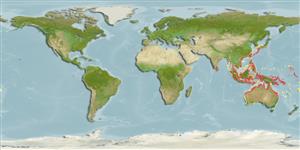Common names from other countries
Environment: milieu / climate zone / depth range / distribution range
Écologie
; saumâtre. Tropical
Indo-West Pacific: from India to Vanuatu; north to southern islands of Japan, and south to Queensland and New Caledonia.
Length at first maturity / Taille / Poids / Âge
Maturity: Lm ? range ? - ? cm Max length : 10.5 cm SHL mâle / non sexé; (Ref. 348); common length : 7.0 cm SHL mâle / non sexé; (Ref. 348)
Widely collected as food in Asia (Ref. 348). Found in intertidal areas in mangrove mud (Ref. 75831, 85174). Also in fresh and brackish waters of mangrove swamps, estuaries, and larger rivers. Highly tolerant to surface desiccation of its habitat; can survive by aerial respiration at the posterior mantle margin for a period of a few days, and feed from subterranean water by means of water exchange through a narrow anterior gape of valves (Ref. 345).
Life cycle and mating behavior
Maturité | Reproduction | Frai | Œufs | Fécondité | Larves
Members of the class Bivalvia are mostly gonochoric, some are protandric hermaphrodites. Life cycle: Embryos develop into free-swimming trocophore larvae, succeeded by the bivalve veliger, resembling a miniature clam.
Poutiers, J.M. 1998. (Ref. 348)
Statut dans la liste rouge de l'IUCN (Ref. 130435)
statut CITES (Ref. 108899)
Not Evaluated
Not Evaluated
Menace pour l'homme
Harmless
Utilisations par l'homme
| FishSource |
Outils
Sources Internet
Estimates based on models
Résilience
Haut, temps minimum de doublement de population inférieur à 15 mois (K=0.76).
Vulnérabilité
Low vulnerability (10 of 100).
Catégorie de prix
Unknown.
